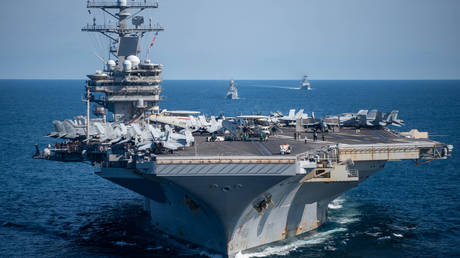
The joint exercise with Japan and South Korea coincides with a renewed escalation with Pyongyang
The US, Japan and South Korea will hold a joint anti-submarine drill involving a nuclear powered aircraft carrier in the Sea of Japan for the first time since 2017, amid tensions over North Korea’s recent missile tests.
The maneuvers, which begin on Friday, will involve the American nuclear-powered aircraft carrier USS Ronald Regan, the South Korean destroyer Menmu the Great, and a Japanese Asahi-class destroyer.
The USS Ronald Reagan and three other US warships arrived in South Korea last week, with the carrier docking in the port of Busan on Friday.
“The training is part of the defense ministry’s steps to restore military cooperation among South Korea, the US and Japan to a level before 2017, so as to respond to North Korea’s nuclear and missile threats,” the South Korean Defense Ministry said on Thursday.
Seoul said North Korea launched two ballistic missiles into the Sea of Japan on Wednesday. A similar launch was reported last week, following a pattern of increased weapons tests by Pyongyang since the start of the year.
The escalation came as US Vice President Kamala Harris met South Korean President Yoon Suk-yeol as part of her Asian tour. Harris praised the partnership between the countries as a “linchpin of security and propensity” on the Korean Peninsula and on the world stage.
The White House said Harris and Yoon discussed joint responses to “potential future provocations, including through trilateral cooperation with Japan.”
Pyongyang has repeatedly said it considers military exercises around the Korean Peninsula that involve the US as a threat to its security. Speaking at the UN General Assembly on Monday, North Korean envoy Kim Song argued that the region was caught in “a vicious cycle of tension and confrontation due to the increasing hostility of the US.”
Kim added that the US-led drills increase the risk of an armed conflict in the region, calling international sanctions on Pyongyang unfair.




